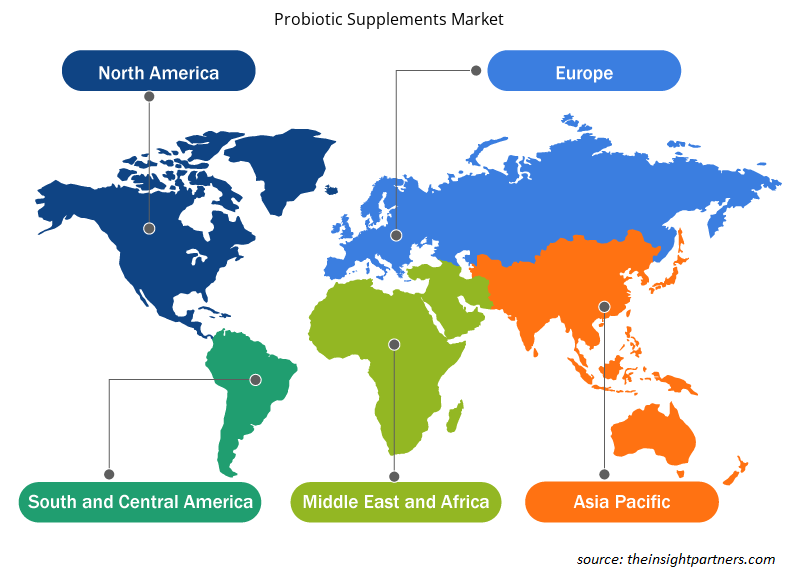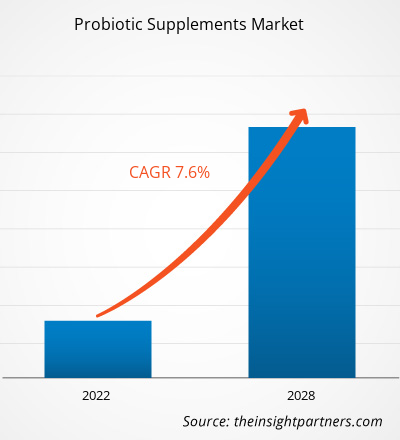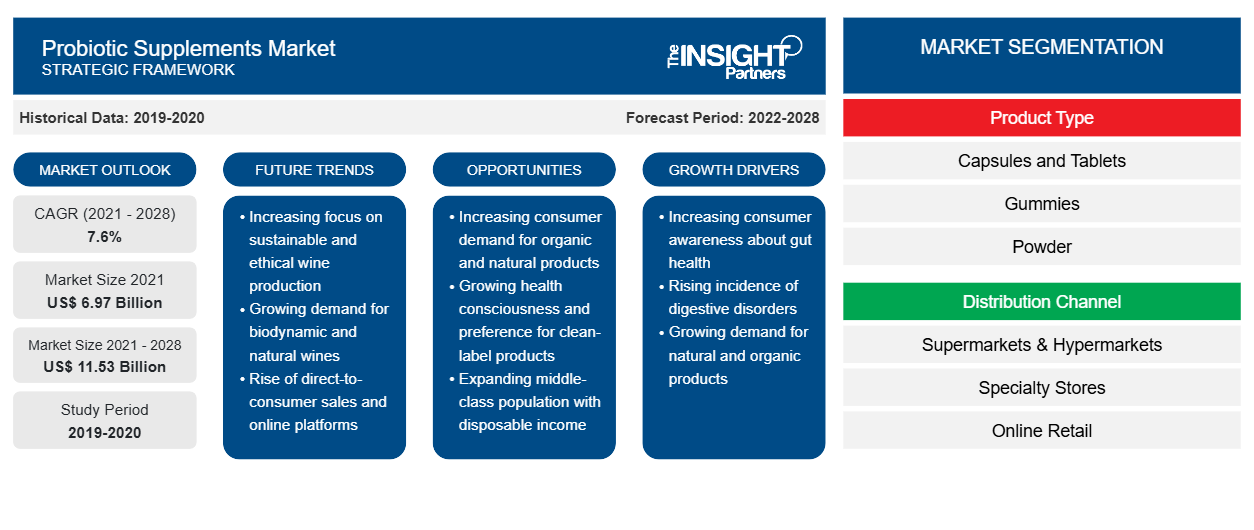Il mercato degli integratori probiotici è stato valutato 6.970,10 milioni di dollari nel 2021; si stima che crescerà a un CAGR del 7,6% dal 2022 al 2028.
Gli integratori probiotici sono microrganismi vivi disponibili sotto forma di polveri, compresse, capsule, ecc.; questi integratori vengono consumati per ripristinare o migliorare la flora intestinale. Il consumo globale di integratori probiotici sta crescendo a un ritmo elevato a causa della crescente prevalenza di disturbi digestivi e della maggiore disponibilità di prodotti per bambini. Inoltre, la preferenza per gli integratori nutrizionali sotto forma di caramelle gommose e la crescente popolarità degli integratori probiotici non OGM e vegani sono tra le principali tendenze che contribuiscono alla crescita del mercato degli integratori probiotici
Nel 2021, il Nord America ha detenuto la quota di fatturato maggiore del mercato degli integratori probiotici. Il consumo di integratori probiotici sta gradualmente aumentando nella regione a causa di fattori quali la crescente consapevolezza dei consumatori sulla salute digestiva e sui ceppi probiotici e sui loro benefici per la salute. Gli integratori probiotici sono disponibili sotto forma di capsule e compresse, caramelle gommose, polvere, ecc., che sono favorevoli per tutte le fasce d'età della popolazione. Secondo un rapporto della GI Alliance, pubblicato il 23 gennaio 2021, 20 milioni di nordamericani hanno ricevuto una diagnosi di malattie digestive croniche. Le malattie digestive, associate a disagio e dolore, rappresentano uno dei problemi di salute più gravi nei paesi nordamericani. La prevalenza delle malattie digestive porta a un aumento delle spese per i trattamenti personali e a una riduzione dell'orario di lavoro. Gli integratori probiotici aiutano a mantenere la microflora appropriata nell'intestino e aiutano a curare le malattie gastrointestinali.
Personalizza questo report in base alle tue esigenze
Riceverai la personalizzazione gratuita di qualsiasi report, comprese parti di questo report, o analisi a livello nazionale, pacchetto dati Excel, oltre a usufruire di grandi offerte e sconti per start-up e università
-
Scopri le principali tendenze di mercato in questo rapporto.Questo campione GRATUITO includerà analisi di dati che spaziano dalle tendenze di mercato alle stime e alle previsioni.
Impatto della pandemia di COVID-19 sul mercato degli integratori probiotici
Nel periodo pre-pandemia, il mercato degli integratori probiotici era guidato principalmente dal consumo di alimenti e bevande funzionali e integratori alimentari e dall'elevata domanda di prodotti ricchi di proteine. Tuttavia, molti settori hanno dovuto affrontare sfide senza precedenti dopo l'inizio della pandemia di COVID-19. I produttori di alimenti e bevande hanno assistito a una lenta crescita nella fase iniziale della pandemia a causa della chiusura delle unità di produzione e delle interruzioni nelle catene di fornitura. Tuttavia, un cambiamento nello stile di vita dei consumatori, un aumento della preferenza per pratiche alimentari sane e un aumento della popolazione attenta alla salute hanno promosso sostanzialmente la domanda di integratori probiotici. Con una maggiore attenzione dei consumatori all'immunità e al benessere durante il periodo di picco della pandemia, anche la domanda di integratori probiotici è aumentata. Molti studi affermano che il consumo di integratori probiotici può aumentare l'immunità, riducendo così il rischio di infezioni, incluso il COVID-19. Ad esempio, una ricerca condotta da esperti dell'Università Sapienza di Roma, in Italia, ha identificato che una miscela di ceppi probiotici, Streptococcus thermophilus DSM 32245 e Bifidobacterium lactis DSM 32246, è abbastanza potente da ridurre il rischio di polmonite grave. Secondo la stessa ricerca, l'elevata concentrazione di batteri rilascia enzimi specifici che modulano le risposte immunitarie dell'ospite.
Approfondimenti di mercato
Iniziative di sviluppo strategico in aumento per guidare la crescita del mercato degli integratori probiotici durante il periodo di previsione
I produttori nel mercato degli integratori probiotici stanno investendo in modo significativo in ricerca e sviluppo, partnership e collaborazioni per lanciare prodotti innovativi per sfruttare le opportunità di mercato emergenti. Ad esempio, a febbraio 2021, Probi, un produttore svedese di ceppi probiotici, e Perrigo, un produttore di integratori per la salute, hanno firmato un accordo per lanciare congiuntamente integratori probiotici mirati alla salute digestiva e immunitaria in 14 paesi europei, tra cui Spagna, Italia e Belgio. In base a questo accordo, le aziende hanno lanciato tre prodotti: Probify Digestive Support, che aiuta a ripristinare la flora intestinale e supporta la funzione digestiva; Probify Daily Balance, che supporta il benessere quotidiano e la salute immunitaria e intestinale; e Probify Travel Protect, che supporta la flora intestinale durante i viaggi. Allo stesso modo, Jarrow Formula ha lanciato integratori gommosi probiotici in tre varianti: gommose duo probiotiche, gommose probiotiche e prebiotiche e gommose probiotiche e immunitarie. Sono a base di pectina, non OGM (non contengono organismi/componenti geneticamente modificati), senza glutine e vegetariani. Non contengono aromi artificiali, dolcificanti, coloranti o conservanti che rispondano a varie esigenze dei consumatori. Si prevede che tali sviluppi forniranno immense opportunità di crescita al mercato degli integratori probiotici nei prossimi anni.
Informazioni sul tipo di prodotto
In base al tipo di prodotto, il mercato degli integratori probiotici è stato segmentato in capsule e compresse, caramelle gommose, polvere e altri. Il segmento delle capsule e compresse ha detenuto la quota maggiore del mercato nel 2021 e si prevede che il segmento delle caramelle gommose registrerà il CAGR più rapido durante il periodo di previsione. Le capsule sono più popolari in quanto hanno meno probabilità di avere un sapore o un odore sgradevole. Gli integratori probiotici confezionati in confezioni di capsule hanno una maggiore biodisponibilità, il che li rende più efficaci. Le compresse sono il tipo di integratore più comune. Inoltre, si prevede che la crescente popolarità degli integratori alimentari come capsule e compresse dovuta al loro costo conveniente, al dosaggio più semplice e alla maggiore durata di conservazione aumenterà la crescita del mercato del segmento delle capsule e compresse durante il periodo di previsione.
Informazioni sui canali di distribuzione
In base alla categoria, il mercato degli integratori probiotici è stato segmentato in supermercati e ipermercati, negozi specializzati, vendita al dettaglio online e altri. Il segmento dei negozi specializzati ha detenuto la quota maggiore del mercato nel 2021. I negozi specializzati sono catene di vendita al dettaglio che vendono una particolare categoria di prodotti. Ad esempio, gli integratori probiotici sono facilmente disponibili in negozi specializzati come farmacie e negozi di nutrizione. I negozi specializzati espongono un'ampia varietà di prodotti di diversi marchi. Questi negozi sono canali di distribuzione ampiamente preferiti per gli integratori probiotici grazie alla loro capacità di esporre un'ampia gamma di gusti, offrire offerte e sconti interessanti e fornire un servizio clienti di alto livello.
Tra i player che operano nel mercato degli integratori probiotici ci sono Bayer AG; Pharmavite LLC; BioGaia AB; Nature's Way Products, LLC; Nestlé SA; SFI Health; GNC Holdings, LLC; Nature's Bounty; Church & Dwight Co., Inc.; e NOW Foods. I player del mercato si concentrano sulla strategia di lancio del prodotto per attrarre grandi gruppi di consumatori, acquisire nuovi clienti, migliorare i ricavi aziendali e soddisfare le mutevoli preferenze dei consumatori. Inoltre, questi player stanno investendo grandi quantità nello sviluppo e nelle innovazioni dei prodotti a causa dei rapidi progressi tecnologici emergenti nel settore e della crescente concorrenza.
Approfondimenti regionali sul mercato degli integratori probiotici
Le tendenze regionali e i fattori che influenzano il mercato degli integratori probiotici durante il periodo di previsione sono stati ampiamente spiegati dagli analisti di Insight Partners. Questa sezione discute anche i segmenti e la geografia del mercato degli integratori probiotici in Nord America, Europa, Asia Pacifico, Medio Oriente e Africa e Sud e Centro America.

- Ottieni i dati specifici regionali per il mercato degli integratori probiotici
Ambito del rapporto di mercato sugli integratori probiotici
| Attributo del report | Dettagli |
|---|---|
| Dimensioni del mercato nel 2021 | 6,97 miliardi di dollari USA |
| Dimensioni del mercato entro il 2028 | 11,53 miliardi di dollari USA |
| CAGR globale (2021 - 2028) | 7,6% |
| Dati storici | 2019-2020 |
| Periodo di previsione | 2022-2028 |
| Segmenti coperti |
Per tipo di prodotto
|
| Regioni e Paesi coperti |
America del Nord
|
| Leader di mercato e profili aziendali chiave |
|
Densità dei player del mercato degli integratori probiotici: comprendere il suo impatto sulle dinamiche aziendali
Il mercato degli integratori probiotici sta crescendo rapidamente, spinto dalla crescente domanda degli utenti finali dovuta a fattori quali l'evoluzione delle preferenze dei consumatori, i progressi tecnologici e una maggiore consapevolezza dei benefici del prodotto. Con l'aumento della domanda, le aziende stanno ampliando le loro offerte, innovando per soddisfare le esigenze dei consumatori e capitalizzando sulle tendenze emergenti, il che alimenta ulteriormente la crescita del mercato.
La densità degli operatori di mercato si riferisce alla distribuzione di aziende o società che operano in un particolare mercato o settore. Indica quanti concorrenti (operatori di mercato) sono presenti in un dato spazio di mercato in relazione alle sue dimensioni o al valore di mercato totale.
Le principali aziende che operano nel mercato degli integratori probiotici sono:
- Società per azioni Bayer
- Farmacia LLC
- BioGaia AB
- Prodotti Nature's Way, LLC
- Nestlé SA
Disclaimer : le aziende elencate sopra non sono classificate secondo un ordine particolare.

- Ottieni una panoramica dei principali attori del mercato degli integratori probiotici
Segnala i riflettori
- Tendenze industriali progressive nel mercato degli integratori probiotici per aiutare gli operatori a sviluppare strategie efficaci a lungo termine
- Strategie di crescita aziendale adottate dai mercati sviluppati e in via di sviluppo
- Analisi quantitativa del mercato degli integratori probiotici dal 2020 al 2028
- Stima della domanda globale di integratori probiotici
- Analisi delle cinque forze di Porter per illustrare l'efficacia degli acquirenti e dei fornitori che operano nel settore
- Sviluppi recenti per comprendere lo scenario competitivo del mercato
- Tendenze e prospettive di mercato, nonché fattori che guidano e frenano la crescita del mercato degli integratori probiotici
- Assistenza nel processo decisionale evidenziando le strategie di mercato che sostengono l'interesse commerciale, portando alla crescita del mercato
- La dimensione del mercato degli integratori probiotici in vari nodi
- Panoramica dettagliata e segmentazione del mercato e dinamiche del settore degli integratori probiotici
- Dimensioni del mercato degli integratori probiotici in varie regioni con promettenti opportunità di crescita
Mercato degli integratori probiotici
"Probiotic Supplements Market Analysis to 2028" è uno studio specializzato e approfondito del settore alimentare e delle bevande, incentrato sull'analisi delle tendenze del mercato degli integratori probiotici. Il rapporto mira a fornire una panoramica del mercato con una segmentazione dettagliata. Il mercato degli integratori probiotici è segmentato in base al tipo di prodotto, al canale di distribuzione e alla geografia. In base al tipo di prodotto, il mercato è segmentato in capsule e compresse, caramelle gommose, polvere e altri. In base al canale di distribuzione, il mercato è segmentato in supermercati e ipermercati, negozi specializzati, vendita al dettaglio online e altri. In base alla geografia, il mercato degli integratori probiotici è segmentato in 5 regioni principali: Nord America, Europa, Asia Pacifico, Medio Oriente e Africa e Sud e Centro America. Nel 2021, il Nord America ha dominato il mercato e si prevede che l'Asia Pacifico registrerà il CAGR più elevato durante il periodo di previsione.
Profili aziendali
- Società per azioni Bayer
- Farmacia LLC
- BioGaia AB
- Prodotti Nature's Way, LLC
- Nestlé SA
- Salute SFI
- Società a responsabilità limitata GNC Holdings, LLC
- La generosità della natura
- Società per azioni Church & Dwight Co., Inc.
- Cibo ORA
- Analisi storica (2 anni), anno base, previsione (7 anni) con CAGR
- Analisi PEST e SWOT
- Valore/volume delle dimensioni del mercato - Globale, Regionale, Nazionale
- Industria e panorama competitivo
- Set di dati Excel
Report recenti
Rapporti correlati
Testimonianze
Motivo dell'acquisto
- Processo decisionale informato
- Comprensione delle dinamiche di mercato
- Analisi competitiva
- Analisi dei clienti
- Previsioni di mercato
- Mitigazione del rischio
- Pianificazione strategica
- Giustificazione degli investimenti
- Identificazione dei mercati emergenti
- Miglioramento delle strategie di marketing
- Aumento dell'efficienza operativa
- Allineamento alle tendenze normative























 Ottieni un campione gratuito per - Mercato degli integratori probiotici
Ottieni un campione gratuito per - Mercato degli integratori probiotici